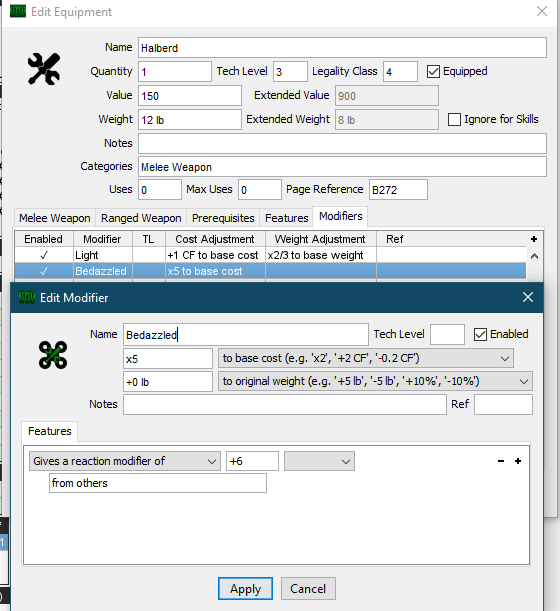My brother moved across the country a few months ago, and to help deal with his social isolation he got up the energy to convince me and some other family members to start a new GURPS campaign. It's been going swimmingly, recaps may or may not be in the works.
That said, it's been a long time since I've GMed a campaign that uses Ritual Path Magic (and the last time the only PC caster was using alchemy), which means it's a perfect opportunity to go over mistakes we've made, as well as pitfalls we've avoided that have come up in play.
Delivering a Spell via Melee Attack is not a Free Lunch
Once created, the missile has to be delivered by touch
(using DX, Brawling, etc.)
Yes, you can put a conditional on the weapon so that a spell takes place when it hits, but short of extremely careful preparation of conditional triggers (good luck convincing your GM to let that slide), you're looking at being one and done as far as those go.
Even the option presented in Pyramid #3-66 The Laws of Magic for Charm 'R' Us doesn't get around this - a ritual charm meant to deal damage after a melee attack still has to be activated with a Ready maneuver, even if the charms inhabit a physical wand or staff, or other object.
For those wondering why delivering a RPM spell via melee attack is still an appealing option:
- Cheaper than adding range and subject weight for internal damage
- No range penalties from attempting to utilize a missile for external damage
- Having actual melee weapon skill allows for better parry than raising Innate Attack skill
Tapping Energy Reserve is a Free Lunch
On the caster’s turn in which the last necessary point of energy has been acquired, he rolls against the appropriate Path skill (Choose the Skill, pp. 19-20) to cast the spell.
Blurring the Lines between Conditionals and Charms is a Bad Idea
Ultimately, forcing Charms to be physical objects that must be readied to use became important to ensuring that mages don't become magic machineguns, dishing our 7d of damage turn after turn after turn. This also introduces potential counter-play (by creating opportunities for enemies to respond before charms are utilized), allowed for people to steal charms created by others, and is overall more consistent.
It also forces more careful thought about the use of conditional spells in general.
The Rule of 16 is Important
If a supernatural attack (magic spell, psi ability, etc.) offers a resistance roll and the subject is living or sapient, the attacker’s effective skill
cannot exceed the higher of 16 and the defender’s actual resistance. If it
does, reduce it to that level.
Example: A wizard has an effective skill of 18 with his Mind-Reading
spell. If he tries to read the mind of someone with a Will of 16 or less,
he rolls against 16. If his subject has a Will of 17, he rolls against 17.
And if his target has a Will of 18 or higher, he rolls against 18.
In our specific circumstance, the Rule of 16 should've kicked in when a practitioner with Path of Mind 19 whammied the party with a Terrify spell. With fright checks, rolling without -3 in penalties can be the difference between being stunned for 1 second and having to roll vs Will to snap out of it, or being stunned for 1d seconds then having to roll vs Will to snap out of it.
No, You can't Bestows a Penalty to the Resist Roll
Penalties that take effect after the magic has successfully affected a target are generally fine.
This one we avoided.
Path Skill Defaults Can't Exceed 12
Drinking a Potion is yet another not Free Lunch
Before using an elixir, you must have it ready. If you
have it exposed (e.g., in a bandoleer), this takes only two
Ready maneuvers (one to draw it, one to open or ready it).
This is one that my group is still coming to grips with, along with another important note on potion use.












